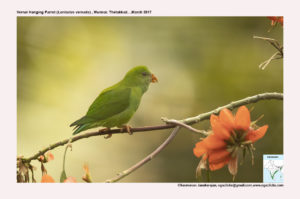
Vernal hanging Parrot Loriculus vernalis
Etymology:
- Loriculus : Derived from Malay name Luri for the colourful lories
- Vernalis : Latin for Green colour
Vernacular Names:Hindi: Latkan, Bhora, Ben: Latkan, Bhora, Cachar: Daobatorlai, Mar: Cheey, Pichu Popat, Mal: Tatta chinnan, Kan: Gubbigini
Distribution in India: Resident of Western Ghats, Eastern Ghats and North East of India.
Description: Size of 13–15 cm; wt. of 35·7 g. The bill is orange-red. The plumage is green, with yellower tone to underparts; pale blue patch on throat; rump and uppertail-coverts are red. The underside of flight-feathers and tail is blue and the legs are orange. The female is paler, with less /or no blue on throat. The immature has dull greyish wash on face and cheeks, rump with green feathers.
Habitat: It is found in evergreen forest, moist and dry deciduous woodlands, secondary growth, abandoned cultivated land, bamboo thickets, forest edge, orchards, tall scrub and beach-strand. It is found up to 1800 m.
Food habits: It eats fruits and berries, flower nectar and seeds. It damages the local crops of guavas in groups.
Breeding habits: They breed in Jan–Apr in India; Jan–Feb in Andaman. The nest is in a natural hollow in rotten tree stem or branch. They lay a clutch of 2–4 eggs. The incubation period is 22 days and the nestling period is around 5 weeks.